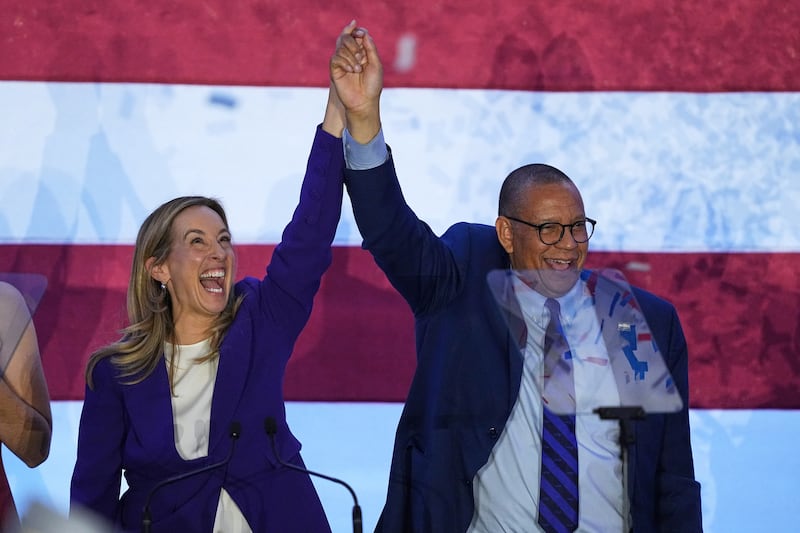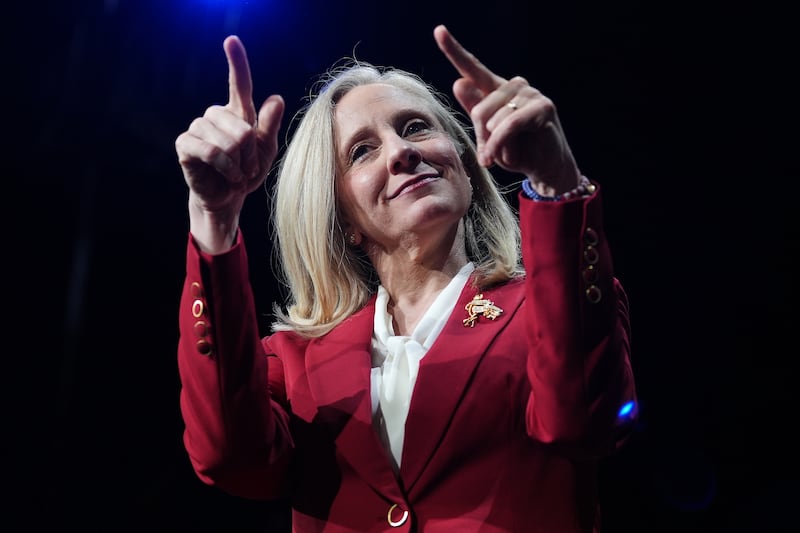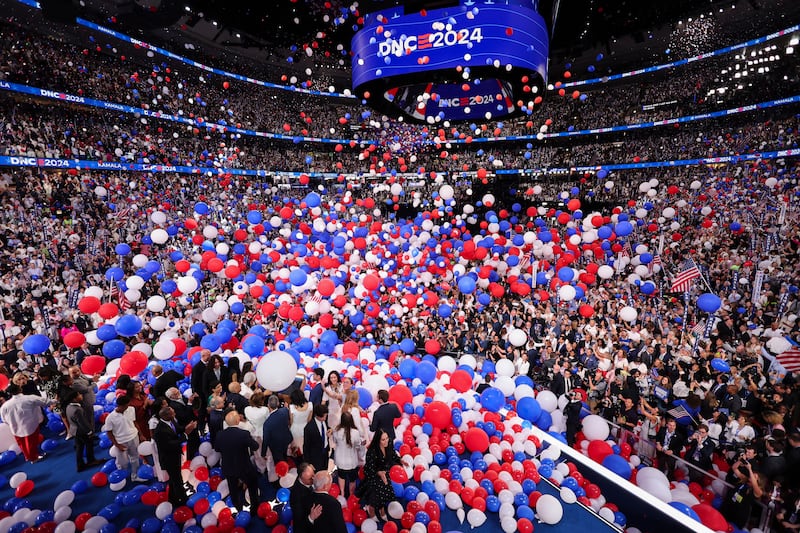Democrats won contests in Virginia, New Jersey and New York City in this year’s elections, pumping much-needed energy into the party after brutal losses across the board in 2024.
Looking forward, the 2026 midterm elections are just a year away and the party still has an uphill battle to flip the House, and potentially the Senate — and earn back the support of so many voters lost in recent years.
In the year since the Republicans won control of the White House and Congress, Democrats have wondered why and where their message went so wrong with voters. Pundits opined on cable news sites, as polling showed how bad the problem was.
But nothing was being offered at a “substantive level” on what Democrats should do differently, Simon Bazelon, a Democratic strategist said.
Bazelon compiled data into a report titled Deciding to Win for Welcome PAC. It aims to (more than gently) nudge Democrats running in future elections to follow what the data shows about the American people.
Why Democrats are unpopular and what they can do about it
According to Bazelon’s research, since 2012, the Democratic Party has adopted unpopular positions on many issues important to voters.
Data from 2013 onward showed congressional Democrats have been co-sponsoring progressive legislation more often and they have moved to the left on nearly every issue.
Issues important to Democratic Party leaders include climate change, democracy, abortion and identity concerns. Meanwhile, issues like the economy and the needs of the middle class took a backseat.
Voters have picked up on that, as there are increasing numbers of people who call the party “too liberal,” while Americans say the Republican Party generally has gotten less conservative over time, Bazelon said.
“A lot of it is about respecting voters and listening to voters. We try to follow the evidence where it leads,” he said of the research.
That evidence pointed Bazelon to see that “winning ideas” can largely come when Democrats move more to the center.
To regain ground with moderate and centrist Republican voters who the party lost over the last decade, Democrats need to become more moderate on issues that have matter to voters, including immigration, public safety, energy and some identity issues, the report says.
“It’s a centrism that is more about aggressively taking the positions that voters agree with on the issue they care about, rather than always taking the middle option between two sides,” Bazelon said. “Sometimes the most popular position will be a left wing position … sometimes the most popular position will be a more conservative position.”
The report doesn’t push Democrats to head entirely to the right or center, highlighting praise for progressives who focus on affordability and economics like Sen. Bernie Sanders, I-Vt., and Rep. Alexandria Ocasio-Cortez, D-N.Y.
Bazelon shared that his research found Democrats running for office need to take accountability for where the party has been. They need to admit the mistakes made under the Biden administration at the southern border or own up to the fact that the party’s messaging hasn’t been focused on the working class issues that once were Democrats’ brand, he said.
At a time when the Democratic Party doesn’t necessarily have a national identity, Bazelon said that there’s a lot of chatter about where the party could go from here.
He knows that some strategists in the party look at the major 2024 election losses, coupled with the second Trump administration, and believe that the Democratic Party needs to move more to the left to win out in the future.
Bazelon’s research shows that it’s actually the opposite and there is a myth in the mobilization theory about moving further to the left. The authors of the report consulted with many in the party, including former Obama senior adviser David Axelrod, statistician Nate Silver and many others.

Data from the last two presidential elections shows that the people who voted for former President Joe Biden in 2020, but then stayed home in 2024, were more moderate or conservative on issues than voters who cast ballots for Biden and then former Vice President Kamala Harris in 2024. The metrics show that as the party moved more to the left, it lost key voters.
“The idea that the way to get them to the polls is to adopt a more progressive agenda on every issue is just directly contradicted by what we see in our data,” Bazelon said.
Nonvoters and swing state voters tend to care about the same issues, including cost of living, the economy, and inflation. They don’t care as much about student debt, climate change and LGBTQ+ issues, he said.
The myth in Democratic politics, Bazelon said, is fueled by people who live and breathe politics, and work in Washington, D.C. Those people tend to be more progressive than the average Democratic voter and often find themselves frustrated with how the party isn’t as progressive as they are.
“When you exist in that social space, it becomes very easy to start to believe that that is reflective of the broader electorate, and that there is some giant pool of people like you who are upset at the Democratic Party because it is not left wing enough,” Bazelon said. “But that’s just not true. It’s not an accurate reflection of public opinion.”
“I think it’s really important for Democrats to begin to understand that.”
The broader electorate, and those the Democratic Party lost in particular, consists of Black voters, Latino voters, working class voters and male voters. Bazelon said that those losses began in 2012, which is coincidentally when the party began to trend more left.
“It’s hard to prove causation, but to me, this pretty strongly suggests that at least part of the reason that we’ve been losing these voters is because of our shift,” he said. “And that shifting further to the left is unlikely to be what wins them back.”
What about the Republican Party?

Bazelon acknowledges that there are Democrats who believe that the Republican Party has become more extreme or more conservative over the last decade — particularly since President Donald Trump entered the political landscape.
The data, however, proves otherwise.
Unlike Democrats who have shifted more to the left, the GOP has dropped many of its unpopular views.
When Mitt Romney ran in the 2012 presidential election, he ran on a fiscally and socially conservative platform. That’s not what modern day Republicans are campaigning on or implementing while in office.
“This is hard for a lot of Democrats to hear, but particularly on economic issues, Republicans have dropped a number of their very unpopular policy commitments, including on issues like Social Security and Medicare,” Bazelon said.
While Trump is a polarizing figure, who Bazelon said pushes some extreme ideas, he isn’t trying to accomplish the things he knows are unpopular. Still, Bazelon noted that there are a number of things the GOP is still extreme on, like immigration and transgender rights, but Democrats should take note that the “extremity is not uniform.”
“Democrats say ‘Democrats need to moderate but Republicans have only gotten more extreme, and that’s worked for them. So why wouldn’t it work for us?’ Well, actually, the reality is that on a number of issues, Republicans in 2024 were more moderate than they were in 2012,” he said.
Bazelon’s research noted that Trump in 2024 was more moderate than Romney in 2012 on a number of issues, including reforming entitlement programs, the Affordable Care Act, same-sex marriage, abortion rights and more.
What the 2025 election means for the party

In 2025, Democrats won statewide positions and passed measures to help the party movingn forward — mostly in blue states. Democratic centrist candidates like Abigail Spanberger and Mikie Sherrill both overwhelmingly won their gubernatorial races and Democrats picked up wins in other elections across the country.
Bazelon, who is celebrating the Democratic wins, also is cautioning the party about putting too much stock into it.
Democrats previously trended ahead of Biden’s 2020 margin, but the trend did not hold when voters cast ballots in 2024 and Harris lost the election to Trump. It proves that there is a “big gap” between turnout in special elections and general elections, Bazelon said.
“I think there’s a risk for Democrats to over-read special election results, and think that all of our problems are fixed,” he said.
He also noted that Spanberger and Sherill’s wins were in blue states that voted for Harris in the 2024 election. The Democratic Party’s problem isn’t winning in Virginia or New Jersey, Bazelon argued, it’s in Ohio, Iowa, Texas and the traditional seven swing states. Those places require “a different approach” for Democrats to win.

However, last week’s election was the first time voters went to the polls since Trump took office earlier this year.
Most exit polls showed that voters’ top concerns were cost of living and the economy, two things Trump made promises about on the campaign trail, but hasn’t seen the support from the public since reentering the White House.
Bazelon argued that one lesson Democrats can learn from the election results is that Trump’s policies are unpopular, at least so far.
“People are very upset about high prices. They’re very upset that he’s not doing much on the cost of living,” he said.
Bazelon’s report found that while most voters still believe that the Democratic Party is “too liberal,” they also for the first time in more than 10 years say the Republican Party is “too conservative.”
The share of voters who saw Republicans as too conservative decreased from 2012 to 2024, but jumped from January to September of this year, coinciding with Trump’s second term.
Bazelon noted that it could be a result of failed campaign promises, but still presents a few opportunities for Democrats – ones that they’re not capitalizing on.
“One is to leverage Trump’s unpopularity to score narrow electoral victories without changing any of our positions, and the other is to sort of seize the middle ground of American politics and win really large victories against Trump and the MAGA movement,” he said.
Relying on the “too liberal” data, Democrats need to convince voters they are less extreme by focusing on issues that working class voters don’t believe the party cares enough about, Bazelon said.
“I think it’s just really important to remember that ultimately, if you don’t win elections, you can’t do anything,” he said. “You can’t protect anybody, can’t improve anything.”


